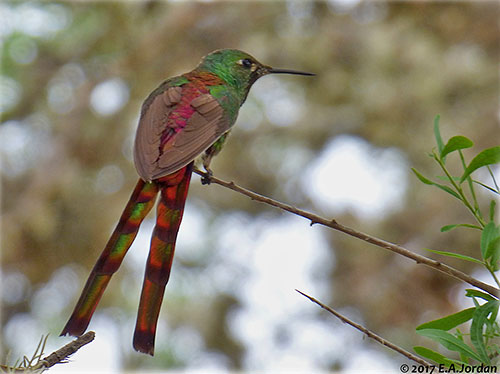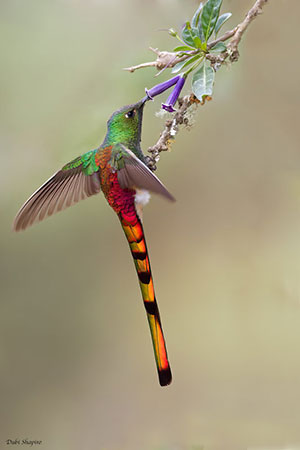
Fr: Colibri sapho
Ang: Red-tailed Comet
All: Goldschwanzsylphe
Esp: Colibrí Cometa – Picaflor cometa (Argentine)
Ita: Cometa codarossa
Nd: Sapphokomeetkolibrie
Sd: sapfokomet
Photographers:
Didier Buysse
Vision d’Oiseaux
Eduardo Andrés Jordan
MIS AVES – AVES DE ARGENTINA
Dubi Shapiro
Dubi Shapiro Photo Galleries
Philippe et Aline Wolfer
GALERIE
Text by Nicole Bouglouan
Sources:
HANDBOOK OF THE BIRDS OF THE WORLD Vol 5 by Josep del Hoyo-Andrew Elliott-Jordi Sargatal - Lynx Edicions - ISBN: 8487334253
Field Guide to the Birds of Argentina and the Southwest Atlantic De Mark Pearman, Juan Ignacio Areta – Editeur: Bloomsbury Publishing, 2020 – ISBN: 1472984331, 9781472984333 – 480 pages
Nectar robbing by the Red-tailed Comet (Sappho sparganurus, Trochilidae): the value of citizen science to document infrequent behavior in birds
El colibrí cometa es declarado patrimonio natural de La Paz
ARGENTINA FAUNA FLORA PAISAJES HISTORIA ARQUEOLOGIA GENTE RELATOS
SOBRE LAS ESPECIES DE AVES EXISTENTES EN LA ARGENTINA Y SUS LUGARES DE AVISTAJE
Ecología alimentaria del Picaflor Cometa Sappho sparganura en la provincia de Córdoba, Argentina
Sistema de Información de Biodiversidad de la Administración de Parques Nacionales, Argentina
Wikipedia, the free encyclopaedia
Wikipedia, la enciclopedia libre
Red-tailed Comet
Sappho sparganurus
Apodiformes Order – Trochilidae Family
INTRODUCTION:
The Red-tailed Comet is one of the most beautiful hummingbirds. It is found in Bolivia and Argentina where it frequents the arid shrubby slopes, up to 2,000 metres of elevation in the south, and higher in the north. Two subspecies share the wide range.
Like other Trochilidae species, it feeds primarily on nectar from flowering plants, but it also consumes small arthropods. It is territorial and defends its feeding territories by chasing other males.
The species is probably polygynous. The nest is a cup-shaped structure placed in tree or on the wall of a rocky gorge. The female alone performs the nesting duties.
The Red-tailed Comet has a large range in which it is described as usually fairly common. The species is not globally threatened at the moment.

DESCRIPTION OF THE BIRD:
Biometrics:
Length: Male: 19-20 cm, including the tail of 7-10 cm – Female: 12-14 cm
Weight: 5 – 6,5 g
The Red-tailed Comet male adult has bright green head, upper back and underparts. A glittering emerald green gorget is conspicuous.
The reddish-purple back and rump contrast with the green head and upper back. The flight-feathers are brownish. Scapulars and lesser coverts are bright green.
The long tail (7-10 cm) is deeply forked. The rectrices are glittering reddish-purple or orange-red, but depending on the light, they may also appear greenish-bronze. Each rectrice shows a broad, black terminal band, forming a regular black-barred pattern at rest. The undertail-coverts are buffy. The undertail is brownish.

On the head, we can see a white spot on the rear of the eye, and a white, descending stripe on the lore.
The bill (17 mm) is black.
The eyes are dark brown.
Legs and feet are black.
The adult female shows similar pattern, but she has a shorter tail and duller plumage.
Head and upperparts are shiny green, but only the rump is reddish-purple. The underparts are pale buff. Throat, breast and upper belly are finely speckled green. The lower belly is uniformly pale buff to whitish. The outermost rectrices have white to buffy-white outer webs. The tail feathers show less conspicuous broad, black tips, only visible on the three outer rectrices.
The juvenile resembles female, but the upperparts are dull bronzy-green, the rump is slightly coppery, and the outer rectrices show more white.
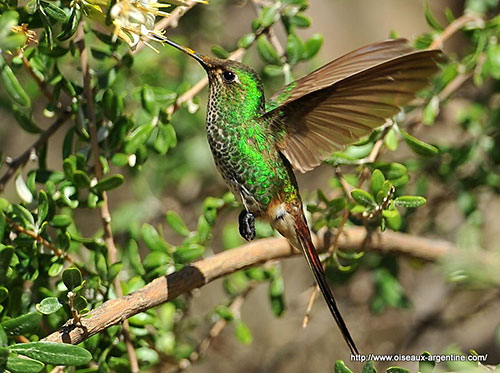
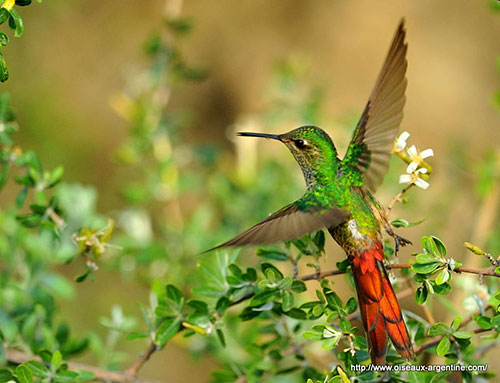
SUBSPECIES AND RANGE:
The Red-tailed Comet has two subspecies.
Sappho sparganurus sparganurus (described above) is found on the E slope of Andes in N Bolivia, and possibly extreme S Peru.
Sappho sparganurus sapho occurs from the Andes of C Bolivia (Cochabamba) and S to N and W Argentina, Jujuy and Salta, S to Neuquén.
This race is similar but slightly paler than nominate, and both uppertail coverts and rectrices are golden-orange instead of reddish-purple.

HABITAT:
The Red-tailed Comet frequents shrubby areas and woodlands. It can be found in dry forests and scrublands in arid montane habitats including rather dry slopes where scattered trees and some vegetal cover provide perches and protection. It may also frequent gorges with dense scrub or semi-arid deciduous forest.
The species has also adapted to gardens and urban parks where several flowering plants provide nectar, its favoured food.

CALLS AND SONGS: SOUNDS BY XENO-CANTO
The Red-tailed Comet produces an unmelodic “tjrrrt” and harsh notes described as “tsha” or “zack” monotonously and rapidly repeated.
The bird alternates high-pitched whistles with descending frequency modulation. These whistles are usually repeated twice, before uttering other sounds while creating an interesting contrast “tiii…tiii…titiri.trrrr…”
But we can hear another sound often considered to be the song. It is described as a short, rapid, jumbled chatter.
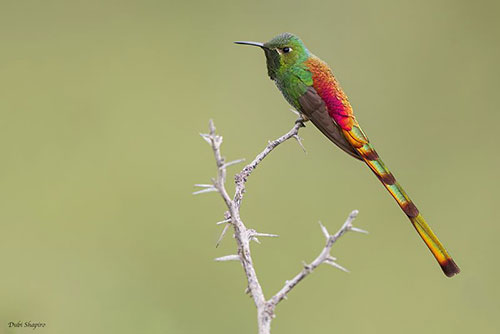
BEHAVIOUR IN THE WILD:
The Red-tailed Comet is typically nectarivorous, but its diet also includes small arthropods such as small spiders, insects, aphids and larvae. The prey are caught in flight, but also sometimes by gleaning them from the vegetation.
The nectar is collected both while hovering and while perched. It takes nectar of flowering plant species including Dunalia, Acnistus, Siphocampylus, Psittacanthus, Castilleja, Salvia, Lamourouxia, Nicotiana and Tripodanthus, and probably others.
It is considered a great pollinator of these plant species.

It favours the plants with high sugar content that helps the bird during its special flight needing a lot of energy.
The wings are very well adapted to hovering. Hummingbirds are very agile in flight, especially when feeding on nectar. The bird is able to hover forwards and backwards. The wings draw flattened “8”, and the wingbeat rate ranges from 70-80 per second in the smallest species, to 10-15 per second in the largest Trochilidae.

Some observations present the first records of nectar-robbing by the Red-tailed Comet in Bolivia.
During this foraging behaviour, the hummingbird takes the nectar by using holes at the base of the corolla instead from the flower’s opening. This behaviour is more frequently reported in species that feed on tubular flowers. The access to nectar is limited for the short-billed species.
The bill of the Red-tailed Comet is about 17 mm long, allowing it to take the nectar from relatively small flowers. This may explain the use of the nectar-robbing method, with records on both native and introduced plant species throughout the range.
As several Trochilidae species do, the males of the Red-tailed Comet defend their feeding territories.
The Red-tailed Comet is generally solitary and fairly territorial. Males are often observed during intraspecific chases when several individuals gather at the same clump of flowers.

At the beginning of the breeding season, the male performs some courtship displays. It sings, exposes the iridescent plumage and performs aerial displays. In the present species, the long, elegant and bright coloured tail feathers fan out during the flight. Such movements create an amazing spectacle similar to a comet crossing the sky, giving the bird its name.

The Red-tailed Comet is polygynous and does not take part in nesting duties. The female alone selects the nest-site, usually near nectar sources. She builds the small, cup-shaped nest and cares for the chicks, while the male mates with several females.
The species is mostly sedentary, but seasonal altitudinal movements are observed, especially in Bolivia (Cochabamba) where the bird is recorded at high elevations in Polylepis patches (family Rosaceae) between October and May, but it is absent during the rest of the year. On the other hand, it remains all year round in Córdoba Province in Argentina.
The Red-tailed Comet is very agile in flight, especially when feeding on nectar by hovering permanently forwards and backwards.
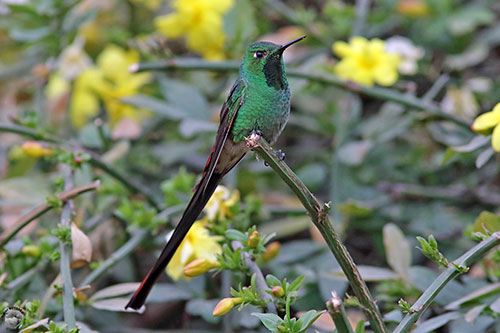
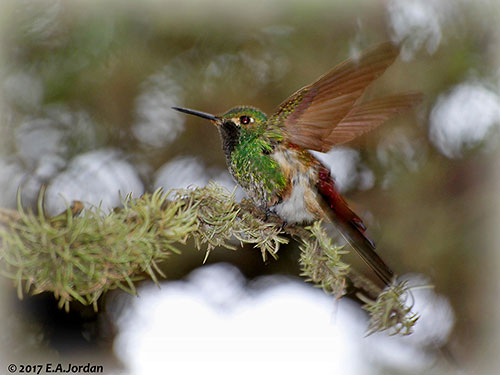
REPRODUCTION OF THIS SPECIES:
The breeding season takes place from April to June in Bolivia and from October to December in Argentina.
The female alone builds the nest, a cup-shaped structure which tapers to a point, forming an inverted cone with a height of 4,5-5 cm and an external diameter of 3,5-5 cm.
The nest is made of mosses, plant fibres, lichens, animal hair and soft plant material, hold together with spider webs.
It is placed in the shade, hanging from branches, ferns or roots. It is usually built in ravines, rocky crevices, caves, rocks, walls of rocky gorges, and sometimes in tree.
The female lays two white eggs. She incubates during 19-20 days and feeds the chicks. They fledge 31-32 days after hatching.
The species often re-uses the same nest, or a new nest is built very close to an abandoned nest.

PROTECTION / THREATS / STATUS:
The Red-tailed Comet has a large geographic distribution in which it is described as “fairly common” throughout the main range.
The size of the population is unknown, but it is suspected to be stable.
The species is not globally threatened and seems to be little affected by human settlements and activities.
The Red-tailed Comet is currently evaluated as Least Concern.
